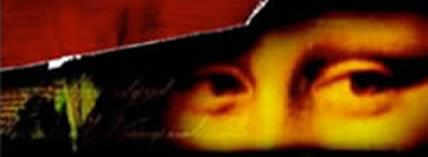'The Da Vinci Code': a novel
The most important word in this entire book is the noun in the subtitle; this is a 'novel' – a work of fiction. That is important to remember, especially after the statements on page 1, which move the work slightly into the arena of historical fiction, but only slightly.
It is true that there are such organizations as the Priory of Sion and Opus Dei. It is true that the author has worked hard to describe accurately the contemporary European locations, including city layouts, buildings, and artwork, in which the plot is set. The statement that "all descriptions of ... documents ... in this novel are accurate" is, however, highly inaccurate!
It didn't take me very long in reading this book to understand why it was the number 1 bestseller on the New York Times list of fiction for a large portion of 2003. It is well-written, fast-paced, with surprising turns of plot and intrigue regularly shocking readers, especially when they start to think they have things figured out. It contains all the elements of a good murder mystery, enough vivid portrayals that one can imagine the events depicted on location – especially if one is familiar with France and Britain – and bite-sized chapters that regularly end with a 'cliffhanger' begging one to read more. Couple all that with regular implicit criticism of organized religion – especially traditional European Catholicism – along with explicit feminist and even goddess-worship ideology, and one understands why many post-Christian readers will approve of the message and virtually all readers will find the plot riveting. I could hardly put the book down myself, wanting to know what would happen next.
This is the first novel that has been reviewed in the six years of the Denver Journal's existence. I am not presumptuous enough to claim to be an expert critic of contemporary American fiction. And more than the barest description of the plot would destroy the fun for prospective readers. The following will have to suffice. The main character, Professor Robert Langdon, a supposed expert in 'symbology' from Harvard, while in Paris as a guest lecturer, has plans to meet with the curator of the Louvre, Jacques Saunière. Before the meeting can happen, Saunière is murdered under bizarre circumstances, and Langdon is seemingly about to be charged with his killing. Strange codes scrawled at the murder scene bring on stage one Sophie Neveu, an expert cryptographer, who turns out to have secret messages for Langdon, leading the two to flee on a trip that begins as an attempt to save Langdon's life and eventually enmeshes them in the famous medieval 'quest for the holy grail' – except that the grail is not the chalice that Jesus used at the Last Supper but... Well, I really can't tell you any more than this without spoiling too much. (Hints of a possible romance between Langdon and Neveu remain only that until the very end of the book and the only sex scene in the novel is a briefly described flashback in Sophie's mind of a grotesque ritual she observed as a young woman.)
Much of what could mislead the careless reader involves the history and contemporary manifestations in Brown's narrative of the two societies, the Priory of Sion and Opus Dei, which prove to be antagonists to each other in his story. Apart from their very general religious objectives and the names of a few famous leaders in the former, almost everything crucial to the plot-line about these two groups is made up. A competent church historian is needed in places, however, to help people understand just where the boundary is crossed between fact and fiction. But what concerns me most, as a New Testament scholar, are the number of people who think that the occasional comments about Jesus, his associates and the literature and events of first three Christian centuries are at all accurate. Put simply, they are not, and even very liberal biblical scholars (as in, for example, the famous Jesus Seminar) agree (see their two books, The Five Gospels [New York: Macmillan, 1993] and The Acts of Jesus [San Francisco: Harper, 1998]).
Specifically, there is not a shred of historical evidence that Jesus ever married Mary Magdalene (or anyone else) or ever fathered children. As Darrell Bock points out in his recent Christianity Today review (January 2004, 62), such information would certainly have been included in 1 Corinthians 9 where Paul appeals to the fact that Peter and various other apostles had wives when they received material help from the churches. In supporting his right to receive such help, Paul would have wanted to appeal to an even more convincing example-Jesus-if it were available. I would add also that with the very early veneration of Mary, the mother of Jesus, in Roman Catholicism, largely out of a desire to have a quasi-divine female figure along with God the Father, had Jesus ever been married, such a woman could scarcely have disappeared without a historical trace. She would have been celebrated and venerated instead, especially in the very strands of Catholicism that The Da Vinci Code pits against the revelation of "the truth" of Jesus' marriage. Brown instead stands this logic on its head when he has Langdon allege that it was so unusual for a Jewish man not to be married that, if he were celibate, that is what the Gospels would have had to call attention to (p. 245). But in a sense that is precisely what they do, at least as Jesus counterculturally approves of a single, celibate lifestyle in Matthew 19:10-12, even if he does not explicitly apply it to himself. And numerous other features in the Gospels call attention to certain ascetic tendencies in Jesus' life (see esp. the survey in Dale Allison's Jesus of Nazareth [Minneapolis: Fortress, 1998] pp.172-216), making his celibacy less surprising. Morevoer, it is not true that "according to Jewish custom, celibacy was condemned" – the Jewish sects known as the Therapeutae and at least some of the Essenes in fact promoted celibacy as a spiritual ideal.
Another blatantly fictitious portion of The Da Vinci Code is the claim that "more than eighty gospels were considered for the New Testament". Add up everything that was ever called a gospel in the first half-millennium of Christianity (most of which are small compilations of esoteric sayings ascribed to Jesus and not narratives of any portion of his life) and you come up with about two dozen documents. About half of these are known only from quotations in early church fathers or small scraps or fragments that have been discovered, and there is little that is unorthodox in them. Others are clearly Gnostic and equally clearly 'Christian' mutations of earlier apostolic tradition. The only apocryphal 'Gospel' that any sizable number of scholars of any theological stripe gives serious credence to is the Coptic Gospel of Thomas, a collection of 114 sayings attributed to Jesus, of which approximately one third are roughly paralleled in the canonical Gospels, another third are clearly Gnostic and non-Christian, and the remaining third are neither necessarily unorthodox nor demonstrably Gnostic. It is in this last group where intriguing questions about what else Jesus might have actually said, not preserved in the canon, primarily emerge. But Brown's characters do not appeal to the Gospel of Thomas at all! For a complete survey of the real apocryphal Gospel literature, see the standard English translation and introduction of W Schneemelcher, New Testament Apocrypha, vol. 1 (Louisville: Westminster, 1991).
Equally false is Langdon's claim that "The Bible, as we know it today, was collated by the pagan Roman emperor Constantine the great" (p.231). While historians do debate how serious Constantine's conversion to Christianity was, he certainly didn't remain a pagan. And he had nothing to do with the canonization of the New Testament. That was a process the roots of which can be documented as early as the mid-second century, culminating in the 39th festal letter of the bishop of Alexandria, Athanasius, delivered on Easter of AD 367, proclaiming the exact 27 books of the New Testament agreed on by all branches of Christianity. It is true that there was dispute from the second to the fourth centuries over seven of the New Testament books, for various reasons (Hebrews, James, 2 Peter, Jude, 2 and 3 John and Revelation), but there is no evidence that there was ever any proposal not to include the Gospels of Matthew, Mark, Luke or John or to include any other Gospel (for the full story see F.F. Bruce, The Canon of Scripture [Downers Grove: IVP, 1987]). Brown further confuses the truth by alluding to the Dead Sea Scrolls as if they included Gospels (p.234), when in fact they contain no Christian documents whatsoever – only Jewish (and a few Greek).
In marshalling support for Mary Magdalene as Jesus' wife, Langdon avers that "the Gospel of Philip is always a good place to start" (p.246). Hardly, since even very liberal scholars agree that this is a late, third-century Gnostic collection. Thus there is little if anything in it that is likely to be historical. What is more, this 'Gospel' exists only in Coptic, not Aramaic (and if there had been a predecessor in another language it would have been Greek not Aramaic, as is demonstrated from other Coptic Gnostic literature), so that it is irrelevant when Langdon goes on to claim that the word 'companion' (which Mary is deemed to be of Jesus) means 'spouse' in Aramaic. It is also worth pointing out that no Aramaic or Hebrew words for 'companion' normally mean spouse! The very short collection of sayings known as the Gospel of Mary (the next plank in Langdon's platform for marrying the Magdalene to Jesus) claims only that Jesus loved her more than various apostles and it comes from an even later (fifth-century) date, though fragments of this document in third-century Greek have been found (but not of this claim).
The enigmatic 'Q-document' has been a favorite among writers of fiction over the years. Scholars use it to refer to material common to Matthew and Luke not found in Mark and many believe that an original Greek collection, largely of sayings of Jesus, called Q for the German word 'Quelle' (in English, 'source'), accounts for the verbal parallelism between Matthew and Luke where they are not following Mark. Scholars hypothesize many other things about Q, most of which are more speculative. None has ever argued that Jesus himself wrote it, but the Da Vinci Code does (p.256). But even if he did, there is nothing secret or scandalous in it; we know what it would have contained by reading the relevant sections of Matthew and Luke!
At several points in various ways Brown's novel makes the claim that Jesus was not considered divine until the fourth century. This, too, is patently false – the claims emerge already in the first-century canonical gospels, as again every biblical scholar of every stripe recognizes. Of course, a lively debate continues as to whether those claims were deserved, but that's quite different from what The Da Vinci Code avers. Larry Hurtado's quite recent Lord Jesus Christ (Grand Rapids: Eerdmans, 2003) in fact demonstrates in massive detail how shockingly early the claims for Jesus' divinity arose – within a few years of his life, something unprecedented in the history of world religions, and something inexplicable unless Jesus himself did and said things that gave rise to those perspectives.
The most sweeping of all the fictitious claims in this book is the idea that the Priory of Sion has preserved "thousands of ancient documents as scientific evidence that the New Testament is false testimony" (p.341). Such documents simply don't exist. This is part of Brown's fiction. The apocryphal and legendary post-New Testament material that does exist has been scrutinized intensely by biblical scholars and is available in English translation (see above; the New Testament Apocrypha has a second volume devoted to 'acts,' 'epistles' and 'apocalypses') for all to read (published in 1992). Nothing in them undermines the New Testament. There is no hidden cache (earlier novels accused the Vatican itself of hiding such documents, not an organization fighting against the Vatican!) being suppressed from the general public.
For readers who want actual scholarship pointing to the reliability of the New Testament, I invite them to consult my books on The Historical Reliability of the Gospels (Downers Grove: IVP, 1987) and The Historical Reliability of John's Gospel: Issues and Commentary (Downers Grove: IVP, 1991). For an excellent study of what can truly be known about Jesus outside the New Testament, see the book with that title by Robert E. Van Voorst (Grand Rapids: Eerdmans, 2000). For an in-depth response to the small number of scholars who do put stock in apocryphal documents besides Thomas, see Philip Jenkins, Hidden Gospels: How the Search for Jesus Lost Its Way (Oxford: Oxford University Press, 2001). For a survey and debunking of modern legends and fictions of various kinds (there are ample predecessors to The Da Vinci Code, and none of them agrees with another!), see especially Douglas Groothuis, Jesus in an Age of Controversy (Eugene: Harvest House, 1996).
Meanwhile, enjoy The Da Vinci Code. It's a fantastic novel. I'm so glad I read it. Just keep reminding yourself throughout, "It's only a novel. It's only a novel."
© 2005 Craig Blomberg



